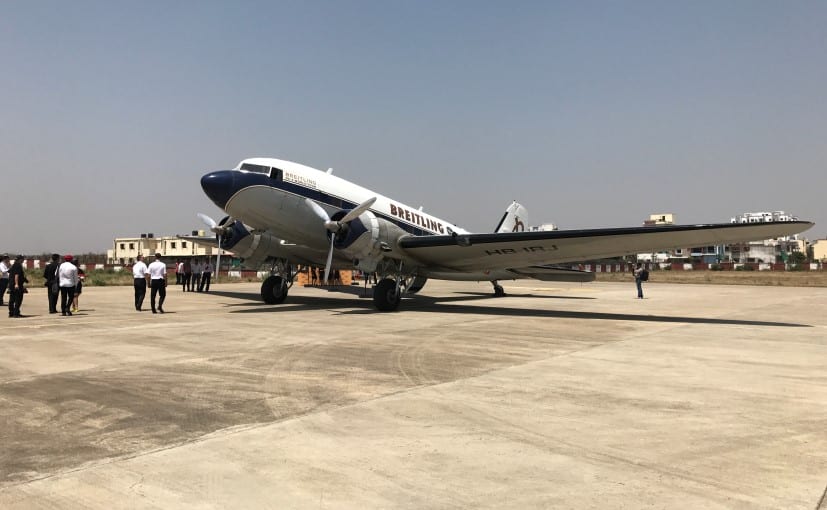Aerospace
WWII 77 years old plane lands in Nagpur, to circle the globe in 6 months.
Seventy-seven years after its first flight, a legendary Breitling DC-3 aircraft, the plane made famous by D-Day during WWII in June 1944 and nicknamed the ‘Normandy landings plane’, has embarked upon yet another historic journey.

According to Mumbai mirror Seventy-seven years after its first flight, a legendary Breitling DC-3 aircraft, the plane made famous by D-Day during WWII in June 1944 and nicknamed the ‘Normandy landings plane’, has embarked upon yet another historic journey.
The DC-3’s crew includes chief pilot Francisco Agullo (48) from Switzerland (he owns the plane), co-pilot Paul Bazeley and researcher Daniel Meyer.
The DC-3 was manufactured by Douglas and was at one time the largest manufactured aircraft in the world, with over 16,000 planes. At present, just 100 remain in air-worthy condition, including the one that touched down in Nagpur. After taking off from Switzerland on March 9, the crew flew to Greece, most of the Middle East, Pakistan and then on to India.
The DC-3 has the ability to take off on short runways. “We require an 800-meter runway for take-off, but for safety, we need approximately 1,100 metres. This aircraft can even land on fields and grassland,” Agullo said.
The plane, which carries most of its own spares, flies at low altitudes. And since it doesn’t have a pressurized cabin, doesn’t have air-conditioning. “On Saturday, we halted at Karachi for refueling and they told us to take an altitude of 5,000 feet, and Nagpur was scorching at 41 degrees. It was really torturous,” Agullo said.
The DC-30 had 30 seats, of which 14 have been removed to carry extra fuel tanks inside. The plane usually carries enough fuel to fly about eight to 10 hours, but with additional tanks, this can go up to an endurance of about 11 hours.
The first DC-3 was built in 1935. The one currently touring the world was manufactured on March 9, 1940. “This is why we chose to start on the 77th birthday of the aircraft,” Agullo said.
They chose Nagpur only because Agullo had visited it on another aircraft on a world tour a few years ago. “Besides, we need a special type of a fuel called AV Gas (also used in small planes like Cessnas), which is available in major cities, and Nagpur is also located in central India,” he said.
After India, the DC-3 will move on to South East Asia, China and Japan, where it has been invited to participate in the Iwakuni ‘Friendship Day Air Show’. It will then begin a grand tour of the United States, prior to returning to Europe via Greenland and Iceland and completing its journey in September, at the Breitling Sion Airshow 2017 in Switzerland.
Agullo and his team will spend nearly a month in Japan, giving joy rides to children. The DC-3 was used extensively during the Second World War, and Japan does not have many left as most of them were destroyed
The DC-3 will undertake a few flights around Nagpur on Monday and Tuesday, and then head to Chittagong in Bangladesh on Wednesday.

Aerospace
Boeing Transfers Rocket Stage to NASA, Paving Way for Human Moon Mission

Boeing has achieved a significant milestone by providing NASA with the second core stage of the Space Launch System (SLS) rocket.
This crucial component, crafted at NASA’s Michoud Assembly Facility (MAF), is set to propel the Artemis II crew into lunar orbit, marking humanity’s return to deep space after a 50-year hiatus.
The monumental Boeing-built rocket stage, the largest element of the Artemis II mission, will embark on a journey aboard the Pegasus barge, traveling 900 miles to NASA’s Kennedy Space Center.
Comparison of two legendary aircraft B777x vs B747 aircraft:Click here
Upon arrival, it will be meticulously integrated with other essential Artemis II components, including the upper stage, solid rocket boosters, and NASA’s Orion spacecraft within the iconic Vehicle Assembly Building. This intricate integration process is a vital step toward the eagerly anticipated Artemis II launch, slated for 2025.
“Boeing-built products helped land humankind on the moon in 1969, and we’re proud to continue that legacy through the Artemis generation,” remarked Dave Dutcher, vice president and program manager for Boeing’s SLS program. “Together, with NASA and our industry partners and suppliers, we are building the world’s most capable rocket and paving the way to deep space through America’s rocket factory in New Orleans.”
NASA, Lockheed Martin Reveal X-59 Quiet Supersonic Aircraft:Click here
The delivery of Core Stage 2 marks a significant achievement in the evolution of the SLS rocket. Towering over 200 feet and powered by four RS-25 engines, this core stage, coupled with two solid-fueled booster rockets, will generate a staggering 8.8 million pounds of thrust. This immense power is crucial to launching Artemis II and future missions into the vast expanse of space.
The SLS rocket stands unparalleled in its capability to transport both crew and substantial cargo to the moon and beyond in a single launch. Its extraordinary capacity will facilitate the delivery of human-rated spacecraft, habitats, and scientific missions to destinations including the moon and Mars, ushering in a new era of space exploration.
-

 Travel1 week ago
Travel1 week agoAir India to Expand US Operations with Three New Routes After a Decade
-

 Travel2 weeks ago
Travel2 weeks agoWhy We Should Avoid These Stamps in a Passport
-

 Airlines1 month ago
Airlines1 month agoInvestigations Reveal Fake Chinese Titanium in Boeing and Airbus Jets
-

 Tech4 weeks ago
Tech4 weeks agoChina’s CATL Plans 1,800-Mile Electric Plane Launch by 2027
-

 Airport3 days ago
Airport3 days agoTop 10 Largest Airports in the World by Size
-

 Aerospace4 weeks ago
Aerospace4 weeks agoChina’s Fighter Jets Turn Wings into Autonomous Drones
-

 Airlines4 days ago
Airlines4 days agoAir India Rolls Out A350s for Delhi-New York JFK and Newark Routes
-

 Defence3 weeks ago
Defence3 weeks agoBoeing Enhances Chinook with New Engines and Block II Upgrades at $96 Million







